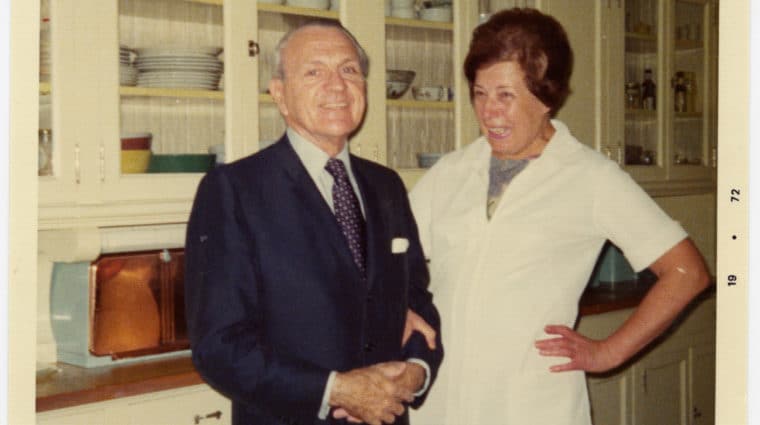The Invisible Wing: Life of a Servant

By Claudia Savin

Filoli, and other country estates like it, could not have run without servants. They are often overlooked, since it was their job to live and work behind the scenes. It required a small army to maintain the estate and attend to the needs of the family, and the work required dedication and discipline from everyone. Most staff members at Filoli lived in the staff wings of the house or in cottages on the grounds. The lower-ranking servants slept two to a room, according to gender, and these rooms were sparse and simply furnished with metal-framed twin beds, dressers, and sinks. In addition to room and board, three square meals a day were provided as part of the job, so that, in theory, a servant could save all of their wages for retirement or to send to family. The Bourn and Roth families are remembered as generous and caring employers, and many Filoli staff members remained in service for many years, or even decades.
The servants were traditionally divided into strict categories and hierarchies. Many English country homes referred to the higher-ranking servant group as the “Upper Ten”, which took their meals in separate rooms at different times than the rest of the staff. These included the butler, valet, housekeeper, head housemaid and lady’s maid. Below them were the cook, scullery maid, chambermaid, governess, chauffeur, and boot boy. Within the hierarchy, the footman served the butler and the boot boy served the footman, hoping to learn enough to move up the ladder.
Footmen were managed by the butler and had somewhat odd roles in the house. They were considered almost decorative, chiefly concerned with serving at meals and opening doors for the family and guests. Because they were hired mainly for show, tall and handsome footmen were well sought-after, and hiring twin brothers was the height of fashion. Mrs. Bourn managed to secure twin footmen at some point in Filoli’s history, which must have impressed her guests.
The housekeeper, who was always referred to as “Mrs.” as a sign of respect, regardless of marital status, managed the female staff and kept an eye out for flirtations between staff members, as well as other bad behavior. She also drew up the servants’ schedules, delegated special cleaning tasks, and managed the store room. The butler had the most prestigious role in the home, choosing wine and cocktail menus with the head of the house, overseeing the silver, and ensuring that everything was running correctly.
Interestingly, there is no evidence of a housekeeper at Filoli during the Bourn era, meaning that the English butler, Sydney Woods, managed both male and female staff himself.
In the formal setting of a grand house, these traditional and well-defined staff structures dictated the staff’s life. It was important to understand one’s official duties and one’s place within the house. Moving suddenly from a lower-tier position to a high one was out of the question, and leaving to enter a different field of work was extremely difficult.

It may seem odd that anyone would want to work in such a strict line of work that left little time for a personal life, but work in grand houses was generally very sought-after. Service exposed them to luxury and style and often paid better than manual or farm labor. Ladies’ maids and valets could travel the world with their employers and visit other grand houses, experiences which would normally have been completely out of reach of a lower or middle-class person.
Of course, the glamour came at a cost. Servants had as little as one half-day off a week and spent most of the year cut off from the rest of the world due to remoteness of the house and the limitations of technology. Staff in English country homes were typically young and unmarried, and the general expectation was that service gave young people work experience and allowed them to save money before marriage, although this isolation made chances of meeting potential partners very slim.
As basic utilities and time-saving appliances began to come to country homes in the mid-19th and 20th centuries, running a large estate became easier and easier. However, after World War I, the number of people willing to enter into service declined sharply. Many long-held ideas about tradition and propriety were changed by the shock of the war, and growth of technology made it possible for young people to work in city centers in shops, factories, and offices.
Because of this, by the 1920s it was rare for a family to keep a large number of servants. Census records for 1930 and 1940 at Filoli show that most of Filoli’s staff were middle-aged during both the Bourn and Roth eras. So, the people who served at Filoli probably saw it less as a waiting period before marriage and more as a long-term career with the aim of a comfortable retirement, something both the Bourns and the Roths made ample provisions for.
As strange as the entire arrangement seems now, the lives of servants and the families they served had a sort of strange harmony, often with familiarity between the two groups but always a sense of boundary. The highly disciplined world in which they lived has all but disappeared, yet it’s still important to examine the societal effects of this elaborate construct, and to stop and appreciate the individuals who spent their lives attending to the needs of others.
Claudia Savin is an Interpretation Specialist at Filoli. Whether on a guided tour, or simply in the House or Garden, our Interpretation staff work with our Volunteer House and Garden Docents to provide a welcoming experience, and to help answer visitor questions, and share stories from the families.
